Monolithic vs Microservices: Choosing the Right Architecture for Your Business
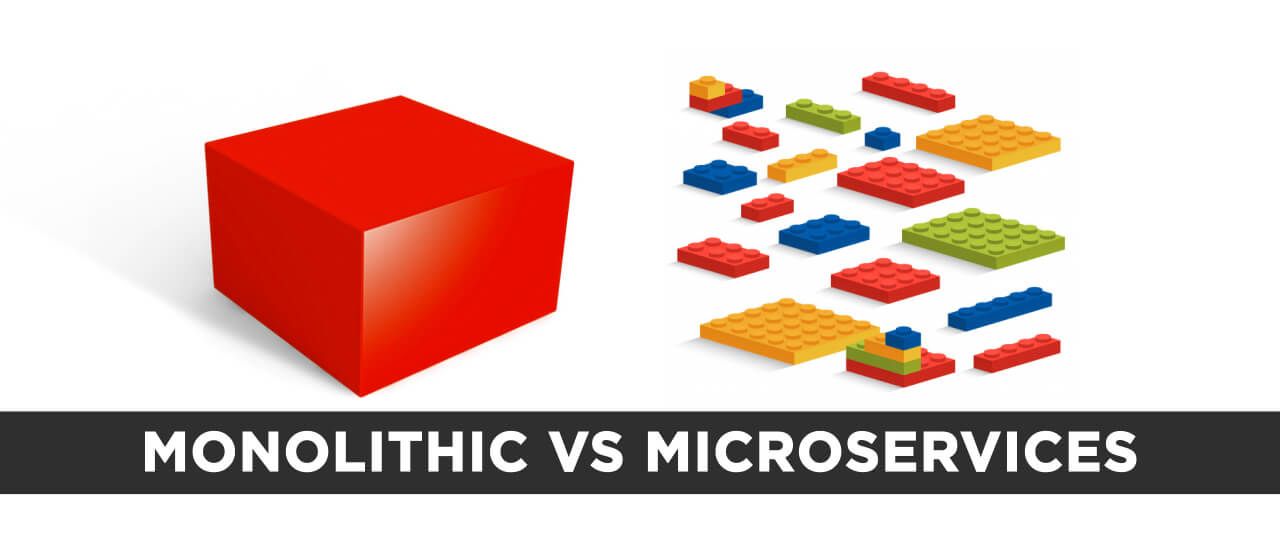
Application development requires not only in-depth knowledge of programming from the team but also analysis. This is particularly so when working on a big project. The choice of architecture is one of the most crucial factors in influencing the outcome.
Sure, you can say the choice of architecture is the developers’ business and why should you care? But remember, the architecture type impacts the project development costs as well as the ability to include new or improved functions. And if you don’t want to rewrite the entire app, take a little time to learn which architecture type handles what.
In this blog post, we’ll take a look at monolithic vs microservices architecture to find out which is suitable for your business and why.
Here’s What We’ll Cover
- Applications Architecture — How Does It Affect Your Project?
- What Is Monolithic Architecture?
- What Are the Pros And Cons of Monolithic Architecture?
- What Is Microservice Architecture?
- What Are the Pros And Cons of Microservice Architecture?
- Monolithic Architecture vs Microservices Comparison Table
- What’s the Difference Between Monoliths And Microservices?
- Monolithic And Microservice: What to Choose
- Choosing between Monolith vs Microservices: The VironIT’s Perspective
- That’s It in a Nutshell: Monolithic Architecture vs Microservices
Applications Architecture — How Does It Affect Your Project?
Before starting a new project, you should understand what the application architecture is.
Application architecture describes the behavior of applications used in a business. It focuses on how they interact with each other as well as with users. Well-designed application architecture ensures the ability of the application to scale effectively and work properly over time under a variety of circumstances. This enables one to minimize both business and technical risks associated with building an application, scaling it, and maintaining it in the future.
Note that different architectures suit different projects. But which one will fit yours? When choosing an architectural style for the creation of your app, you should determine your needs, project type, goals, and future outlook.
Now, let’s find out which one is best for your project—monolithic or microservices.
What Is Monolithic Architecture?
In software development, a monolithic pattern is designed to be a single indivisible unit. Usually, a monolithic app consists of a database, client-side user interface, and server-side application.
All the components have been combined into a single program, and all its functions are managed in one place. They are interconnected and interdependent. So, if any component is updated, the whole application has to be rewritten.
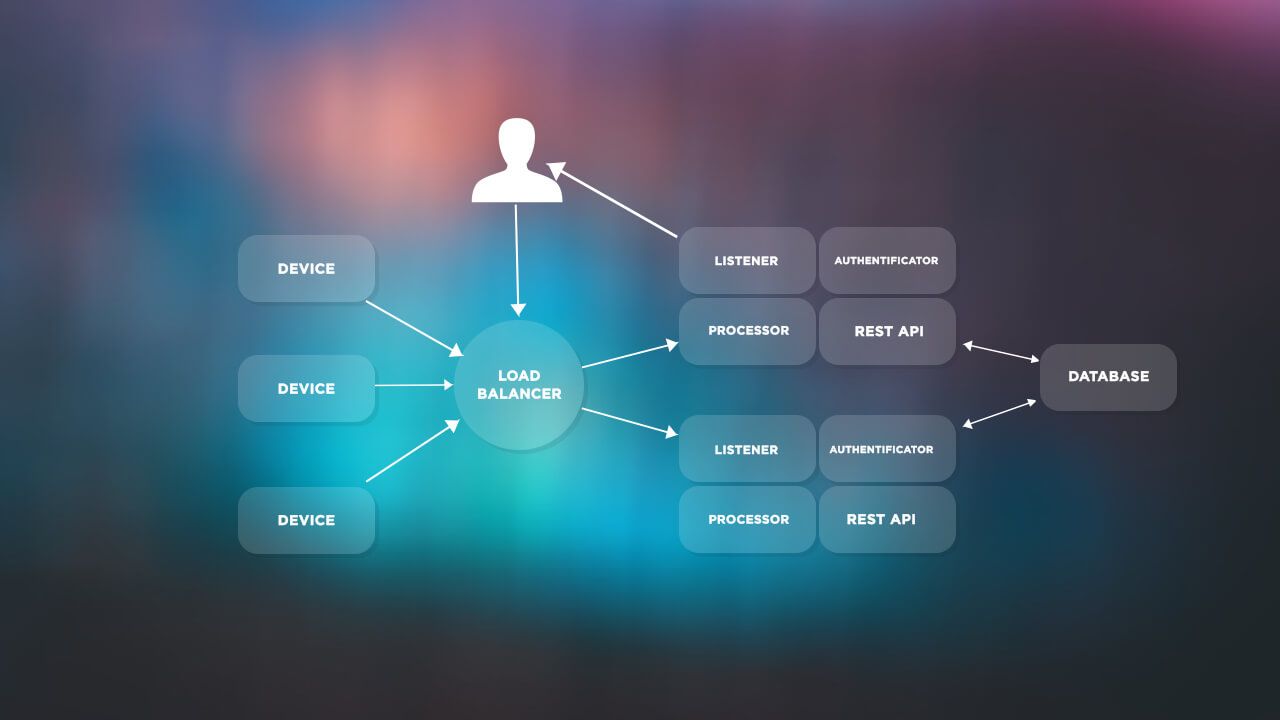
What Are the Pros And Cons of Monolithic Architecture?
For some situations, the monolithic software architecture works well. For instance, it suits startups that need to get a product up and running as soon as possible. Other companies prefer to stay monolithic despite the popularity of microservices.
So, to find out whether this solution fits your business, let’s consider its pros and cons.
Advantages of the Monolithic Structure
- Simple development. As monolithic applications perform as a single unit, you don’t have the hassle of inter-process communication of the app’s components. There are a lot of tools you can adapt to facilitate a monolithic app development so it will take less time to develop such apps, compared with microservices.
- Fast deployment. The monolithic app deployment process is quite straightforward: you only need to copy a single archive to one definite directory. You don’t need to deploy changes or updates separately, as you can do this all at once, saving time.
- Reusable components. If an issue arises, you can reuse code from other applications to solve it. Code reuse will also improve time-to-market for your app.
- Better performance. If built properly, monolithic apps provide faster communication between software components, due to shared code and memory.
- Straightforward testing. As the application is deployed at once, there’s no need to wait for additional dependencies to run testing.
- Seamless sharing. Since the code is stored in one database, it can be easily shared across all the stages of the development.
Monolithic Architecture Weaknesses
- Complicated scaling process. When an app’s component requires more resources, it is difficult to isolate such a component for independent scaling. In the case of a monolith, every change leads to a whole system redeployment.
- Difficult to adopt new technologies. If there’s a need to add new technology or functionality to your app, you may face some issues. Adding new technology means redeploying the entire application, which requires both time and effort. At the same time, without implementing new technologies, your business may lose market share.
- Limited agility. Every update requires full redeployment of the entire application. This means that all the developers have to wait to see the impact of a small change, which greatly reduces the team’s agility and frequency of new deliveries.
- Difficult to understand. Module dependencies make the app’s architecture more complex and hard to understand, especially for new developers who join the team.
- Low speed. The twenty-million line code base overloads the IDE, which increases development time and slows down the start-up time.
- Poor reliability. One bug or issue in the system can stop the entire process, as all the components are interconnected.
What Is Microservice Architecture?
Unlike the monolith model, the microservices approach divides complex applications into smaller parts. The resulting system consists of various services that communicate with each other through a message broker, a database, and a REST API. These services are independently deployable by fully automated deployment machinery.
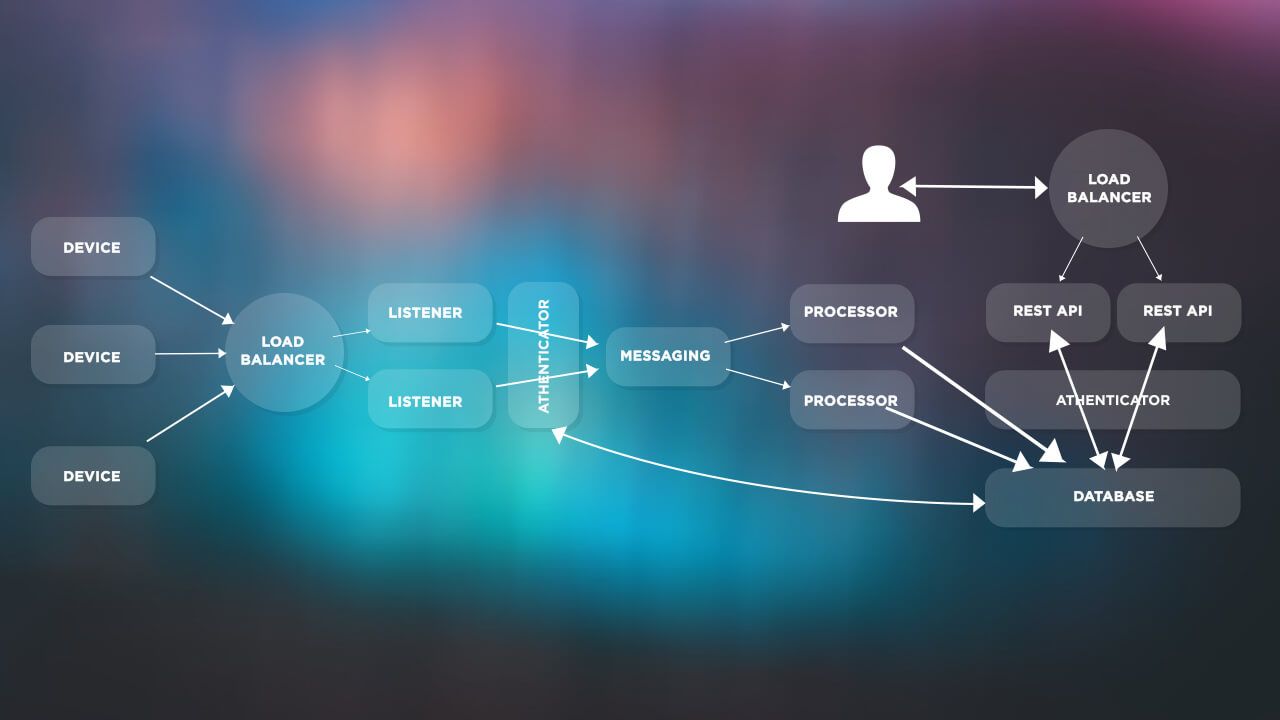
What Are the Pros And Cons of Microservice Architecture?
Microservices also do not suit all app types. For instance, they work well when you have multiple teams or your app is complex enough to break it into services. Companies like Netflix, Amazon, Twitter, eBay, and PayPal have evolved from a monolithic approach to microservices. To find out whether microservices suit your project, let’s consider the pros and cons of this architecture.
Advantages of Microservices over the Monolithic Structure
- Easy to understand, develop, test, and deploy. As the code base is small, you can focus on one particular module and fully understand it. This facilitates and speeds up development and release. Additionally, the release of one unit isn’t limited by the release and maintains smaller services than one large one.
- Increased agility. As each unit can be built independently, you can update system components without bringing down the whole application. Moreover, new features can be added as needed without waiting for the whole app to launch.
- Better scalability. Independent units can scale horizontally or vertically, depending on your needs. Scaling isn’t limited by the capacity of each service and can be completely automated. You can isolate services that require a greater workload and scale them independently of the rest of the app.
- Variety. You can choose any programming language, multiple frameworks, and technologies within one service. If necessary, you can easily adapt and take advantage of the latest emerging technologies.
- Reliability. A bug will affect only the unit in which it occurs so it will not bring down the entire application. This greatly enhances the reliability of the system.
- Flexible teams. Some services can be created by a couple of developers; others require the collaboration of a large team. For improved productivity, you can form mobile and flexible teams.
- Easier to identify faults. Such services will naturally have a smaller codebase and be less complex than a monolithic one. This simplifies the identification and resolving of errors.
Weaknesses of the Microservice Architecture
- Less stable. An individual microservice may be well-tested, but when combined with some common microservices and programs, it is hard to test every configuration. Additionally, as you combine them, they may interact in unforeseen ways.
- Less secure. It is not always easy to tell where microservices reside, which can make securing them a pain. This also provides more opportunities to penetrate the system.
- Difficult to make the transition. It will take time and discipline to replace the monolith with the microservices architecture, but many companies have accomplished this and found the investment worthwhile.
- Complexities of monitoring. While the system as a whole may live for a long time, its components—the containers—do not. They live and die quickly.
- Higher associated costs. Each microservice requires a runtime environment. These apps require more resources, which leads to higher associated costs.
- Skill demands. As each module requires its own team of developers, you should incorporate many specialists to achieve the goal of the project.
Monolithic Architecture vs Microservices Comparison Table
What architecture should you choose for your business? It will be more convenient to explain the differences between monolithic and microservices architectures with a comparison table.
| Monolithic architecture | Microservice architecture | |
| Development | As all teams operate simultaneously on the same piece of code, the development of monolithic architecture could take more time and effort than microservices. | As each application can be delivered individually, microservices enable rapid app development. |
| Deployment | You can deploy and then customize your solution based on the current changes. Yet, if something runs incorrectly, the whole project can break down. | As each microservice should be implemented individually, the deployment process can be more complicated. But, if something goes wrong, only one module will fail. |
| Reliability | If something goes wrong, the whole structure could stop. Meanwhile, in microservices architecture, breaking one service will not cause critical problems in the overall application. | If one module is broken, the others will continue to operate. This flexibility provides you with fast development and the ability to change one function without interfering with others. |
| Scalability | Scalability is tricky to achieve and upgrade, due to the size and scale of the structure. | In this case, scalability is much easier because you can scale only those modules that require more resources. |
| Release | Due to the microservice architecture, new app features can be released faster and more seamlessly. | A monolith means a single-tiered software application that cannot be divided into smaller units. So, common schedule delays can affect the release of the entire project. |
| Maintenance | For maintenance, you should be aware of .NET, Java, DB2, etc. The testing process is painless, but finding errors and making changes is time-consuming. | With microservice architecture, your teams are likely to use a wider variety of testing techniques that better suit this architecture. This can allow for faster time to market, lower cost, and less risk. |
| Cost | Monolith architecture is more affordable and faster to develop. But note, monoliths require putting your money into a single stock, which is a large risk and strain on the budget. | Microservices are often more expensive than a monolith. But taking into account the developer’s work hours, in the long run, they can cost less than a monolith. |
What’s the Difference Between Monoliths And Microservices?
Above we have defined the terms monoliths and microservices. But what do they really mean?
Monolithic architecture runs on a single application layer that joins all architecture functionalities. This architecture doesn’t involve as many actors as other architectural styles. To build a web architecture using a monolithic approach, you would start developing its front-end and enable its access to data.
Let’s imagine that you are building a new taxi application to compete with Uber. You would create a new project manually or by using a generator that comes with Rails, Spring Boot, Play, or Maven. This new application would have a modular architecture, shown in the following diagram:
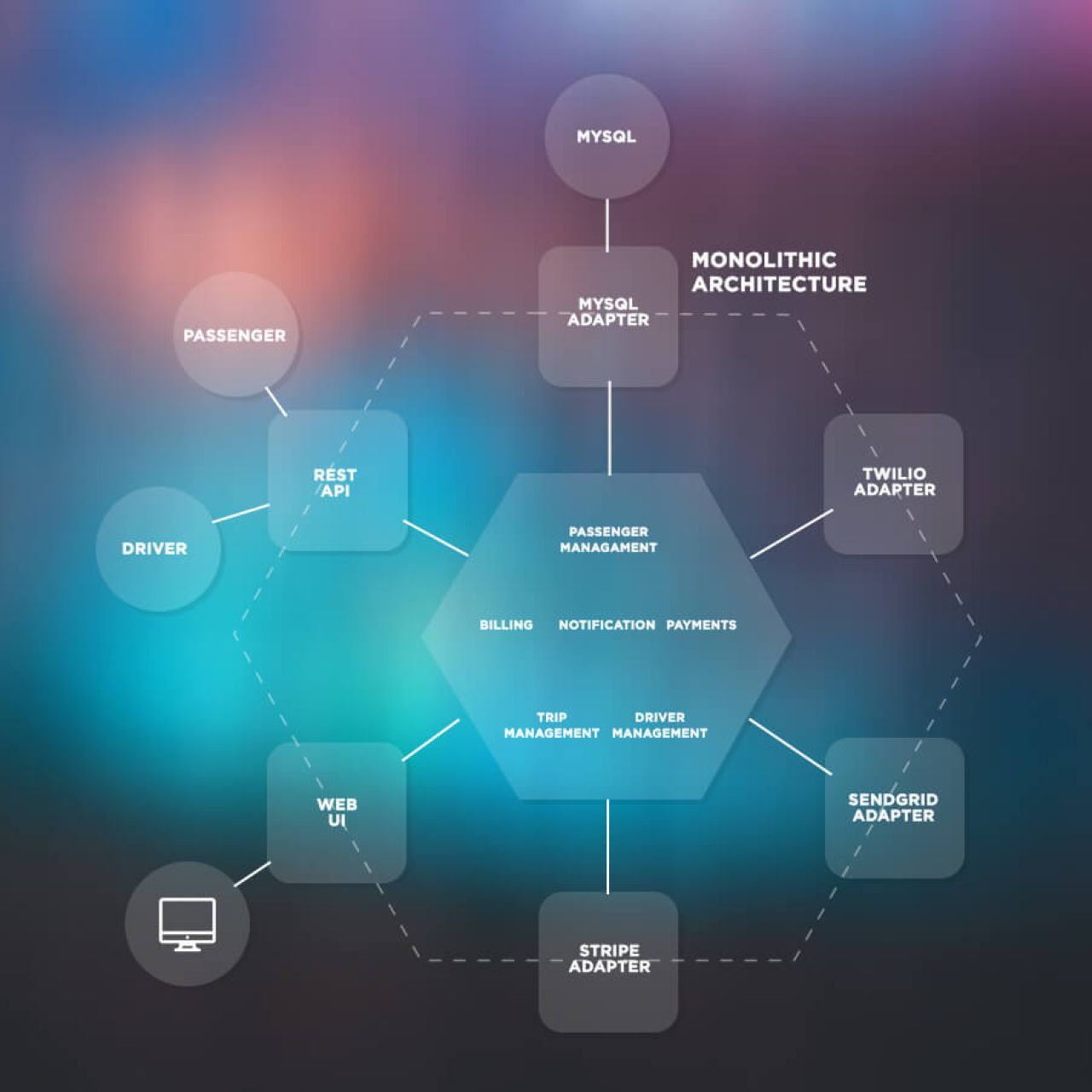
Unlike monoliths, microservice architectures consist of independent services with a nothing-shared architecture. This architecture focuses on responsive-actor programming. Here’s a diagrammatic representation for quick understanding:
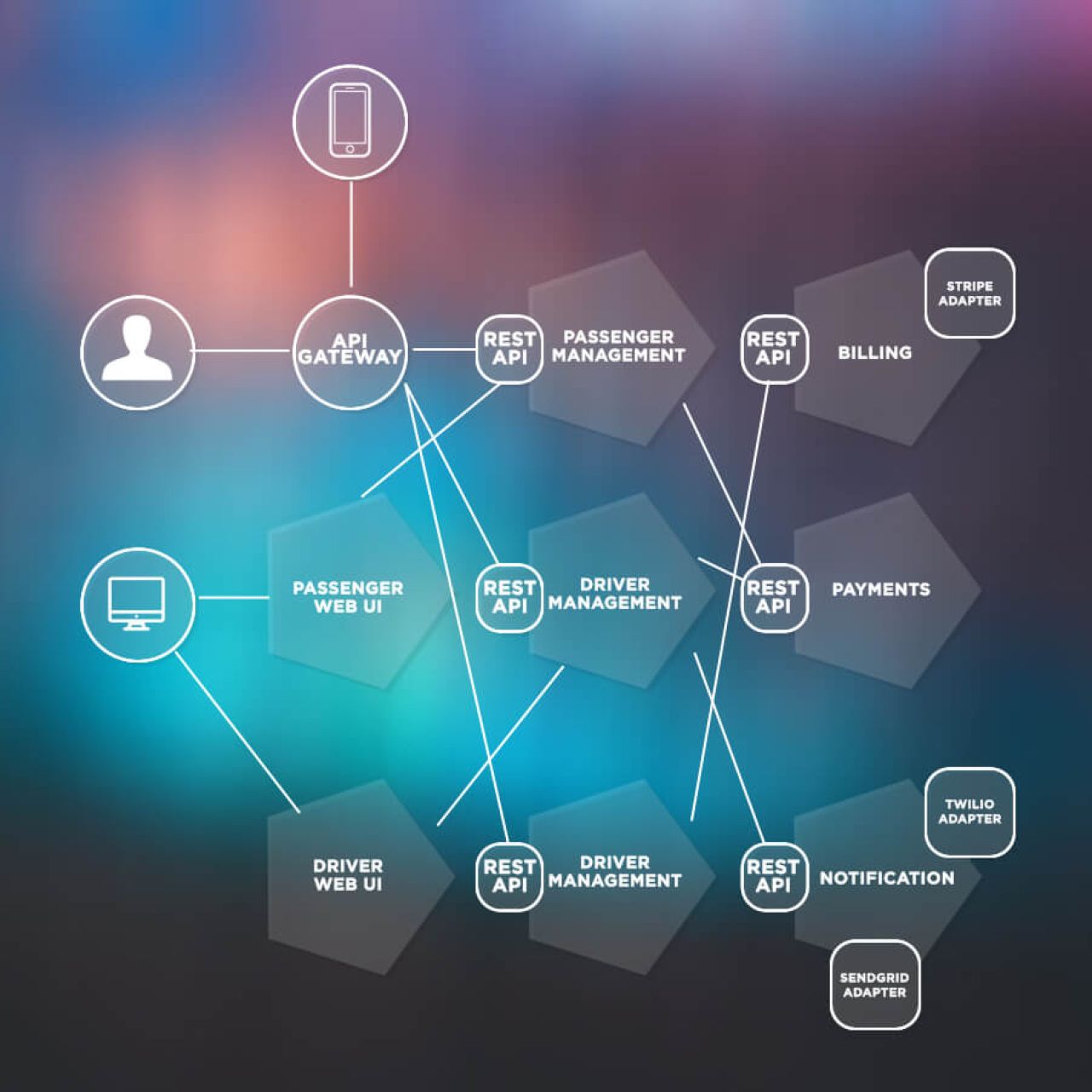
To save you some clicks, we will explain the difference between monoliths and microservices using one picture that represents them as food.
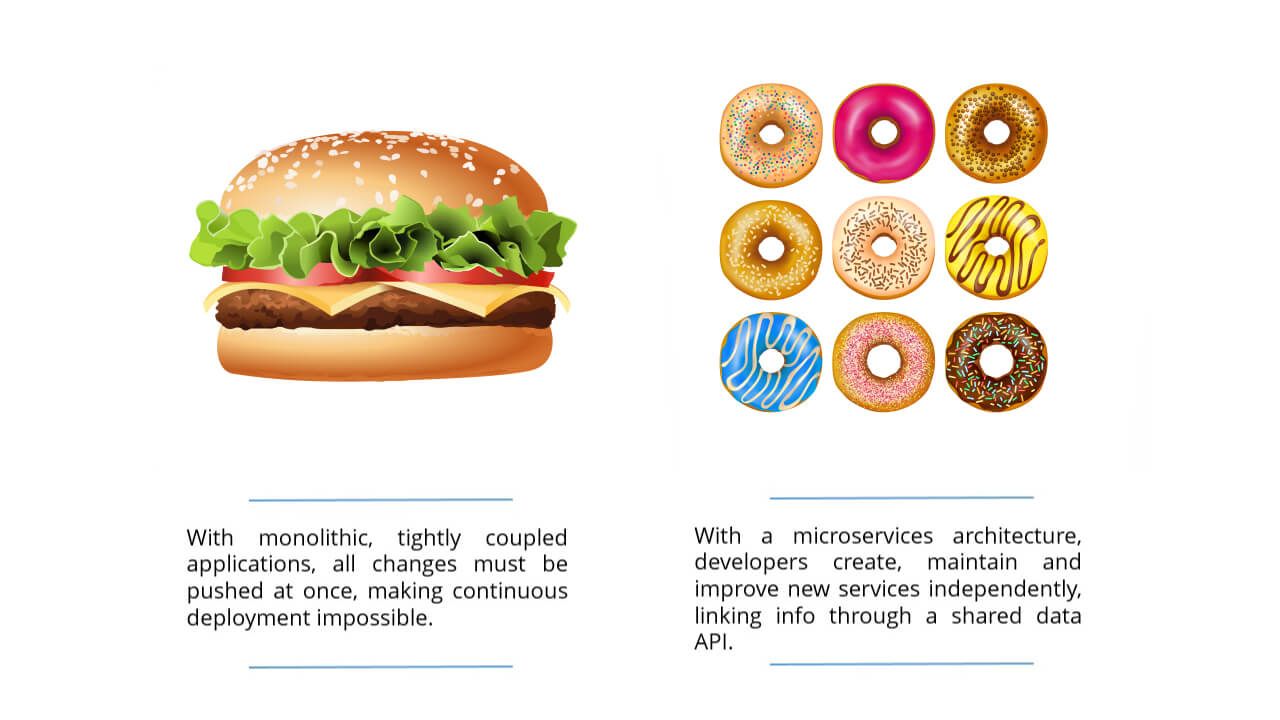
Monolithic And Microservice: What to Choose
When to Use Monolithic Software
Following are some points explaining why you should start your project using monolithic architecture:
- You’re building the MVP. Are you building a small business project without complex business logic and scalability? If so, the monolith will help you with rapid product iteration.
- Your team is at the founding stage. If your team consists of 2–5 members, it could be tricky to tackle a broader and high-overhead microservices architecture.
- You have no microservices experience. If your team has no experience with microservices and has to learn “on the fly”, it’s another sign you should start with a monolith.
- You are on a tight deadline. The monolithic architecture allows you to launch the first version of your project within 2–3 months.
- You have a limited budget. Monolithic application development costs less and requires fewer resources than microservices.
What Are Some Examples of Monoliths?
Excellent examples of monoliths are Flickr, Jira Service Desk, and Etsy (until 2018). These are types of monolithic, PHP-based applications with efficient development models, and they are not deploying once a day.
Note: In 2018, the Etsy online marketplace began a migration of a ten-year-old monolith to the Cloud.
When to Use Microservices
Now, let’s consider some points that show you when you should use microservices:
- Fast and independent service delivery is required. Microservices allow you to deliver individual parts within a large and integrated system.
- Part of your platform should be more efficient. If you need to process a large volume of data, you’ll likely want to build a service in a very efficient language like C++ or Java.
- You plan to increase the number of team members. You plan to build multiple independent teams that would work on different functions of your solution.
- You need many data sources. You develop a project with an extensive data pipeline for data collection, aggregation, etc.
- You apply machine learning algorithms. An example of this would be if your app focuses on collecting, aggregating, and analyzing data flow.
- You migrate from monolithic architecture. If you refactor monolithic modules and run them as microservices, machine learning algorithms can be useful.
- Your app has complex business logic. You create a complex project and are going to leverage the most suitable solution for each feature.
What Are Examples of Microservices?
Large-scale companies like Netflix, eBay, Amazon, the UK Government Digital Service, Twitter, PayPal, and The Guardian have migrated from monolithic to microservices architecture. Let’s consider some success stories:
- Netflix has successfully migrated from a traditional monolithic to a cloud-based microservices architecture. Now, the company receives more than one billion calls each day from 800 different devices to its streaming-video API. Each API call then prompts around five additional calls to the back-end service.
- Amazon made a change from the Obidos monolithic to a microservice with encapsulated databases and “two-pizza” teams. Its microservices receive countless calls from a variety of applications. So, Amazon dramatically improved its front-end development life-cycle. The company makes 50 million deployments a year, thanks to the microservice architecture and their continuous delivery processes. However, Amazon has never used the term “microservices.”
- eBay’s core application comprises several autonomous applications. Each one executes the business logic for different functional areas.
- Before adopting microservices, Walmart had an architecture for the internet of 2005. The company decided to re-platform its system in 2012, since it could not handle 6-million page views per minute and retain any kind of positive user experience.
- Spotify serves more than 75 million active users per month, with an average session length of 23 minutes. To avoid synchronization problems within the organization, Spotify adopted microservice architecture with autonomous full-stack teams. The company has 600 developers and more than 90 teams, the functions of which do not overlap with each other.
- China’s equivalent to Facebook, WeChat, runs on more than 2k microservices. They are constantly innovating, with impressive growth and a portfolio of services.
Choosing between Monolith vs Microservices: The VironIT’s Perspective
Microservices architecture has become increasingly popular. But, we can’t say that microservices will work best for one or another project. Your business context is crucial while considering to start with monolith or microservices.
Focus not only on the architectural approach but also on the specific requirements of your project. That will help you to a technical decision. Before choosing the architecture type, you should consider things like business goals, project type and road map, budget, and much more.
For example, a monolithic system often suits better a lightweight music application. For a complex streaming app, we recommend you to choose microservices architecture.
That’s It in a Nutshell: Monolithic Architecture vs Microservices
Note that one approach doesn’t fit all projects. Monolithic and microservices both have their advantages and disadvantages.
For a lightweight application, a monolithic system is often better suited. Such apps are faster and easier to develop. However, they are harder to scale.
For a complex, evolving application with clear domains, microservices will be the preferred choice. But, such projects require more time to be developed as well as more management efforts.
To determine the best architecture for your app, you should focus on the specific needs of your business, and analyze your goals along with the app’s scaling plans.
If you want to know which architecture will suit your business app, contact us, and we’ll be happy to answer all your questions.

 (5 votes, average: 4.80 out of 5)
(5 votes, average: 4.80 out of 5)


